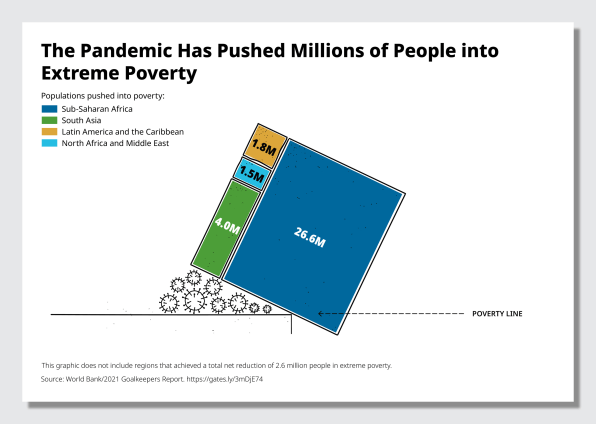COVID pushed 31 million people into extreme poverty
For decades, the percentage of people around the world living in extreme poverty—surviving on less than the ridiculously low amount of $1.90 a day—has been dropping. The pandemic reversed that trend. In an annual report that looks at the world’s progress on the Sustainable Development Goals, the Gates Foundation says that 31 million additional people have been pushed into extreme poverty because of COVID-19.
“There are people who might have exited poverty in the last few years or the last decade through growth and all of the progress that has been made, and unfortunately, have fallen straight back in,” says Vishal Gujadhur, deputy director of development policy and finance at the Gates Foundation.
Economic recovery from the pandemic is also proceeding unequally: While people in 90% of rich countries are predicted to be back to pre-pandemic per capita income levels by 2022, the same is true in only around a third of low- and middle-income countries. “It will take them years to get back to where they used to be,” he says. That means progress on reducing poverty will move slowly: By the end of the decade, nearly 700 million people may still be living in extreme poverty.

Part of the challenge is the delays in rolling out COVID vaccines in lower-income countries: While some rich countries like the U.S. are beginning to administer third doses, only around 1% of people in low-income countries have gotten even one shot. “Until we sort of have more equal distribution of the vaccine, as well as other medical countermeasures, I just don’t think we’ll get back to where we hoped it would be for an equitable recovery,” says Gujadhur. Wealthier countries need to donate more vaccine doses. “We’ve done the numbers, and there are enough vaccines around for donation to happen,” he says. (That’s true even if the donor country is offering third doses.) Along with more support of COVAX, a global initiative focused on equitable access to vaccines, donations could help make it possible to distribute more than 2 billion doses in low- and middle-income countries by the first quarter of next year.
In the longer-term, more low-income countries can ramp up their own capacity to manufacture vaccines—so when the next pandemic inevitably happens, those countries can quickly respond, both saving lives and losing less ground on poverty reduction. In Africa, for example, the African CDC is working with partners like the Gates Foundation to scale up a regional system of vaccine development and manufacturing on the continent.
To help people catch up financially, some of the strategies used during the pandemic should likely continue, like direct cash transfers. “Countries were able to scale up really quickly in a way that they might not have thought was possible just a year or two years ago,” Gujahdur says. “It was proven you can do it in low-income countries’ settings, you can reach a large portion of the population, and you can do it fast.”
(34)



